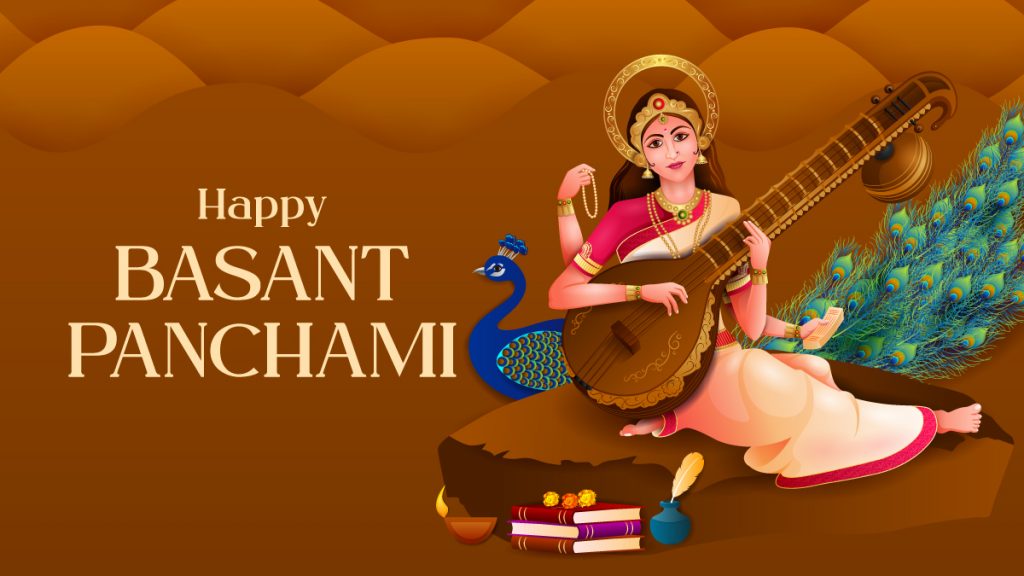Basant Panchami, also known as Sri Panchami, is a significant Hindu festival that heralds the arrival of the spring season in India. Celebrated on the fifth day (Panchami) of the Hindu month of Magha (January-February), this festival is dedicated to Goddess Saraswati, the goddess of knowledge, wisdom, music, and the arts.
Basant Panchami is a time of joy and renewal, marked by prayers, educational activities, kite flying, and the wearing of yellow, symbolising the vibrant colours of spring.
Table of Contents
Basant Panchami/Sri Panchami Dates in India for 2024, 2025, and 2026
Here are the dates for Basant Panchami/Sri Panchami in India for the upcoming years:
The Significance of Basant Panchami/Sri Panchami in India
Basant Panchami is primarily associated with the worship of Goddess Saraswati, who is revered as the source of wisdom, knowledge, and creativity. On this day, students, scholars, musicians, and artists pay homage to the goddess, seeking her blessings for intellectual growth and artistic inspiration. The festival also marks the onset of spring, a time of renewal, growth, and vibrant colours in nature.
In northern India, particularly in Punjab, Basant Panchami is also celebrated with kite flying, symbolising the joyous spirit of the season. People dress in yellow, the colour of spring, and enjoy outdoor activities, music, and festive meals.
How Basant Panchami/Sri Panchami is Celebrated in India
Basant Panchami is celebrated with enthusiasm across India, with regional variations in customs and rituals. The festival is a blend of religious devotion, cultural activities, and the celebration of nature’s beauty.
- Worship of Goddess Saraswati: On Basant Panchami, people perform Saraswati Puja, especially in schools, colleges, and homes. Books, musical instruments, and tools of trade are placed near the goddess’s idol as offerings. Devotees seek her blessings for knowledge, wisdom, and success in their studies and creative pursuits.
- Educational and Cultural Activities: In educational institutions, Basant Panchami is observed with special prayers, speeches, and cultural programmes. Students are encouraged to participate in art, music, and literary activities to honour Goddess Saraswati’s influence on knowledge and creativity.
- Kite Flying: In regions like Punjab, Haryana, and parts of Uttar Pradesh, kite flying is a major part of Basant Panchami celebrations. The sky is filled with colourful kites, and people engage in friendly competitions, adding to the festive atmosphere. The tradition of kite flying symbolises freedom, joy, and the arrival of spring.
- Wearing Yellow: The colour yellow is closely associated with Basant Panchami, symbolising the blooming mustard fields and the vibrancy of spring. People wear yellow clothes, prepare yellow-coloured sweets and dishes, and decorate their homes with flowers of the same hue.
Basant Panchami/Sri Panchami in Different Parts of India
Basant Panchami is celebrated with regional variations, reflecting India’s cultural diversity.
- West Bengal: In West Bengal, Basant Panchami is also known as Saraswati Puja, and it is one of the most important festivals for students and scholars. Schools and colleges organise special pujas, and students place their books and pens at the feet of Goddess Saraswati, seeking her blessings for academic success.
- Punjab and Haryana: In Punjab and Haryana, Basant Panchami is synonymous with kite flying. The skies are filled with colourful kites, and families gather on rooftops to celebrate the arrival of spring. The day is marked by outdoor activities, music, and traditional Punjabi meals.
- Uttar Pradesh and Bihar: In Uttar Pradesh and Bihar, Saraswati Puja is performed in homes and educational institutions. People offer prayers to the goddess, and children often begin their formal education on this auspicious day, symbolising a new beginning in their academic journey.
- Rajasthan: In Rajasthan, Basant Panchami is celebrated with great enthusiasm, particularly in the city of Jaipur. People dress in yellow, fly kites, and enjoy traditional Rajasthani food, marking the transition from winter to spring.
Basant Panchami/Sri Panchami – A Festival of Knowledge, Colour, and Spring
Basant Panchami is not only a celebration of knowledge and wisdom but also a festival that honours the beauty of nature and the arrival of spring. The festival brings together people of all ages in a spirit of joy, renewal, and devotion. From students seeking blessings for academic success to families enjoying the outdoor festivities of kite flying, Basant Panchami reflects the vibrant and diverse culture of India.
As the season of spring begins, Basant Panchami serves as a reminder of the power of knowledge, the beauty of nature, and the joy of new beginnings. It is a festival that inspires creativity, learning, and a deep connection with the natural world.
More Information about Basant Panchami/Sri Panchami in India
Is Basant Panchami a public holiday in India?
Basant Panchami is observed as a restricted public holiday in several states across India. It is widely celebrated, particularly in northern and eastern India, with special prayers and cultural activities.
How is Basant Panchami celebrated in India?
Basant Panchami in India is celebrated with prayers to Goddess Saraswati, kite flying, wearing yellow clothes, and participating in educational and cultural activities. The festival marks the beginning of spring and is a time of joy and renewal.
What is the significance of Saraswati Puja during Basant Panchami in India?
Saraswati Puja is performed during Basant Panchami to honour Goddess Saraswati, the goddess of knowledge, wisdom, and the arts. Students and artists seek her blessings for success in their studies and creative pursuits.
Why do people wear yellow on Basant Panchami in India?
Yellow is the colour of spring and is associated with the blooming mustard fields during this time of year. Wearing yellow on Basant Panchami symbolises the vibrancy of nature and the joy of the season.

